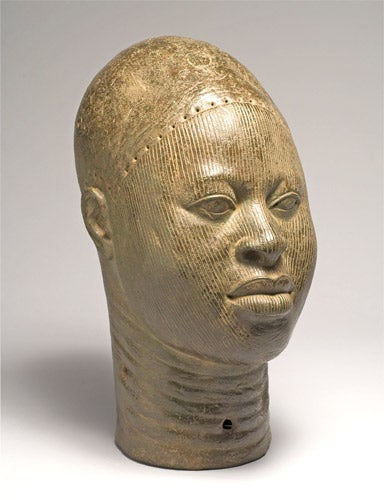Kingdom of Ife: Sculptures from West Africa, British Museum, London

There are so many Africas, and so many arts of Africa. Picasso and Matisse thought they had hit on the essence of Africa during the first decade of the 20th century. The African masks and sculpture that influenced such works as Les Demoiselles D'Avignon (1909) seemed to be the very embodiment of a youngish Spaniard's priapic idea of the primitive: wonderfully, savagely stylised; bursting with a toe-curlingly alien erotic charge. How patronising of Picasso to think that that's what African art amounted to. Well, perhaps that's a little unfair. The point was that Picasso, ever grasping, ever restless, was seeking out new ways of representing the female body.
Yes, anthropologists quickly began to prove that Picasso was either wrong or telling just one tiny part of an immensely complicated story. In 1910, the first major excavations took place at Ife, a site in what is now south-western Nigeria, not too far from Lagos. (The walled city-state of Ife, legendary homeland of the Yoruba, flourished for 300 years, from about 1100-1400 AD). Thirty years later, in 1940, another great cull of objects from the same site hit the headlines again: "Worthy to rank with finest works of Greece and Italy", shrilled the Illustrated London News.
Many of the works that those anthropologists found are now on display in this major show of north-west African sculpture, and the works here lend credence to that headline writer's claim. At the same historical moment that Andrea del Verrocchio was doing his wonderfully painstaking, high-Renaissance drawing of a female head which can be seen elsewhere in this building, anonymous artisans in Ife were working with brass, bronze – yes, these Africans knew all about bronze casting long before the Europeans arrived to show them how – copper and terracotta to produce a series of exquisite heads that are not only the equal of Donatello in technical brilliance, but also just as naturalistic in their refinement. So much for African primitivism.
There is much more to see than heads, mere heads, in this show, of course – there is a gorgeous stone representation of a mud fish, lying so slyly low on its rather proper-looking maroon plinth (granite body; menacingly plug-like, iron eyes) and the scaly crocodile; there are intimidatingly indomitable monoliths from sacred groves; there are extraordinary terracotta sculptures of bodies disfigured by ricketts and elephantiasis (look out for the hugely swollen testicles); and there is also a wonderful top of a staff, which shows the heads of two male criminals, back to back, one young, the other old, their mouths gagged with rope to prevent them cursing their fate – but it is to the heads that we return, again and again. Such is their extraordinary visual seductiveness.
A typical Ife head is life-size. The expression is beautifully serene, the surface smooth, cheek bones often quite prominent, lips full, neck long. The face is likely to have vertical striations. The head may be adorned with a tiered head-dress or a delicate pillbox hat, built up in concentric rings, simulating woven basketry. The abdomen is likely to be adorned with swags of beads. If a king is being represented, look out for rosettes, a beaded crown.
What were these heads for, we ask ourselves repeatedly. Were they memorials? Did they beautify altars? Were they made for coronation ceremonies? One of the most exquisite is described as the copper mask of Obdufon II, who was the Ife's third king. In spite of the fact that it weighs in at five kilos, the mask was actually made to be worn by some long-suffering devil – surely not the king himself. Below the eyes you can see small, crescent-shaped slits – the wearer would have been able to see through these slits. What marvels he would have seen – nothing quite so marvellous as himself though.
To 6 June (020 7323 8181)
Join our commenting forum
Join thought-provoking conversations, follow other Independent readers and see their replies
Comments